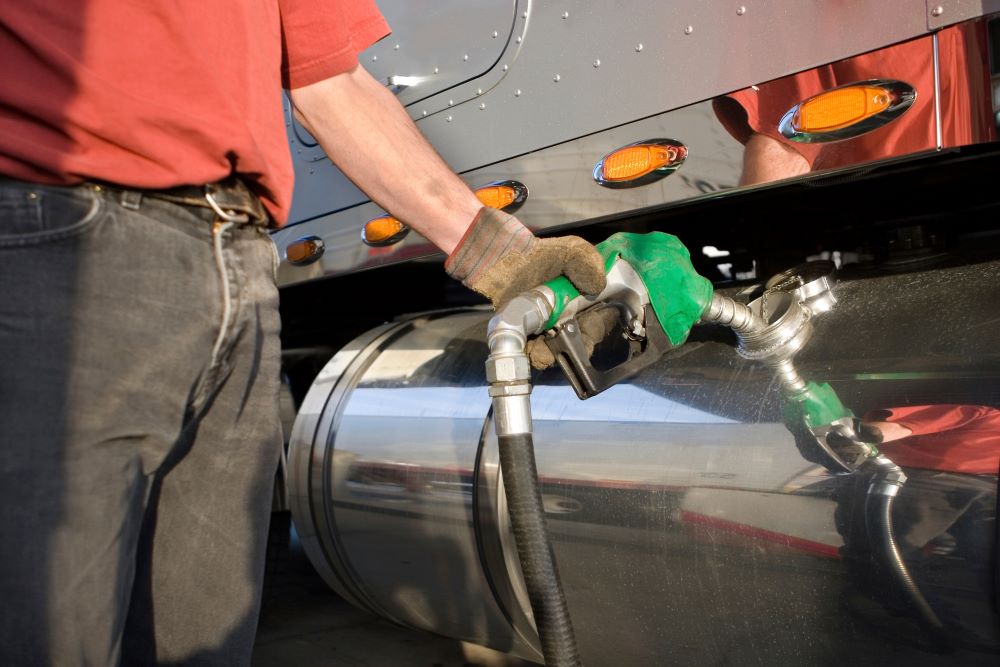
The trucking industry keeps the world moving, delivering everything from groceries to construction materials. But there’s one essential (and expensive) resource that trucking relies heavily on: fuel.
Diesel powers the trucks that connect businesses and consumers, but fuel prices are anything but predictable. A sudden spike at the pump can disrupt budgets and eat into your profits, creating serious challenges for carriers and owner-operators.
That’s where fuel surcharges come in. A fuel surcharge offers a system that shares the burden of fluctuating fuel costs. Basically, instead of fuel increases cutting into your profits, a fuel surcharge protects your business when fuel costs rise.
Understanding how these surcharges work is essential for staying profitable and fair, whether you’re a shipper, a carrier, or an independent trucker. We’ll cover everything you need to know in the guide below.
What is a Fuel Surcharge?
A fuel surcharge in the trucking industry is an extra fee added to freight bills that helps carriers offset the fluctuating costs of diesel fuel.
Adding a fuel surcharge became common practice as fuel prices had big ups and downs, making it difficult for trucking companies to maintain stable operating costs. As a result, fuel surcharges became widely adopted, allowing carriers to adjust their rates based on fuel price changes, which often change weekly.
While there’s no standard formula for calculating fuel surcharges, each carrier typically uses their own method to help them manage the impact of volatile fuel expenses.
The Purpose of a Fuel Surcharge
A fuel surcharge helps trucking companies and owner-operators handle the unpredictable changes in diesel fuel prices. It protects carriers from losing money when fuel costs rise, making their operating costs more stable.

This extra fee ensures carriers can keep its business running smoothly without being forced to absorb sudden fuel price spikes. At the same time, it creates a fair system for both carriers and clients by keeping freight pricing transparent and tied to real fuel costs.
Fuel surcharges don’t cover all fuel expenses, but they make the increases more manageable.
How Does the Fuel Surcharge Work?
Freight bills include fuel surcharges to help trucking companies handle changing fuel prices.
Carriers and shippers often agree on surcharge terms in their contracts, using a baseline diesel price. This is typically based on weekly reports from the US Energy Information Administration (EIA).
Surcharge rates go up or down depending on how fuel prices change. For contract freight, these fees are consistent and agreed upon in advance. In spot freight markets, surcharges are adjusted more flexibly to match the current fuel costs.
With a system like this, you maintain fair pricing for both parties while helping carriers manage fuel expenses without constant renegotiation.
How Does Fuel Surcharge Work for Owner-Operators?
As an owner-operator, dealing with fluctuating fuel prices can be a real pain in managing your business operating costs.
Fuel surcharges help owner-operators manage this by compensating for the extra cost of diesel. So, when fuel prices fluctuate, the fuel surcharge ensures the price hike won’t eat into your profits.
These surcharges are typically based on a per-mile rate that adjusts as fuel prices go up or down. While fuel surcharges can sometimes provide extra earnings, they depend heavily on fuel efficiency and proper calculation.
To keep it fair, owner-operators should include clear fuel surcharge terms in their contracts and base calculations on reliable data, like the EIA’s fuel price reports.

Calculating Fuel Surcharge Fees
We calculate fuel surcharges using key variables to fairly offset fuel price fluctuations. Here’s how they work:
- The base price of fuel: The base price of fuel is a predetermined “baseline” cost used as a reference. This is an agreed-upon threshold, which is based on national averages like the US Department of Energy’s weekly diesel price reports. If the current price rises above this baseline, it triggers a surcharge.
- The truck’s fuel economy: Miles per gallon (MPG) determines how much fuel a truck consumes. A loaded semi-truck averages about 6 MPG, so better fuel efficiency lowers the per-mile cost of fuel. This efficiency directly impacts the surcharge rate.
- The fuel price change: Fuel surcharges account for the difference between the base price and the current fuel cost. Regular updates from indexes like the DOE ensure accurate tracking.
How is a Fuel Surcharge Calculated?
While the exact calculation method can change for each carrier, here’s how it’s typically done.
Per Mile Surcharge
Subtract the base fuel price from the current fuel price to find the price difference. Divide this difference by the truck’s MPG to get the cost per mile.
Multiply the cost per mile by the total miles traveled to determine the surcharge amount.
Percentage of Load Price
Some carriers use a percentage surcharge based on the load’s price. The rate increases as fuel prices rise above the base price, using a predefined table.
For example, a surcharge might start at 10.25% and rise to 10.5% as fuel costs increase.

Example of Calculating Fuel Surcharge
Here’s an example of calculating a fuel surcharge. Say the base fuel price is $3.50 per gallon, the current fuel price is $4.00 per gallon, and the truck gets 6 MPG.
First, find the price difference: $4.00 – $3.50 = $0.50.
Next, divide by the truck’s MPG: $0.50 ÷ 6 = $0.083 per mile.
If the trip covers 1,000 miles, the surcharge is $0.083 × 1,000 = $83.
Now, if the truck’s MPG drops to 5, the per-mile cost increases to $0.10, making the surcharge $100 for the same trip.
Small changes in fuel price or MPG can significantly affect these costs, so accurate calculations are essential.
National Average for Fuel Surcharge
The national average for fuel surcharge is generally determined using the US Energy Information Administration’s (EIA) weekly updates on diesel fuel prices.
Truckers and businesses use this average as a benchmark to set fair and transparent fuel surcharge rates.
This data keeps surcharges accurate, reflecting real market conditions for fair and transparent fuel surcharge calculations.
Where to Find a Current Fuel Surcharge Table
To find a current fuel surcharge table, start with the EIA’s fuel price reports, which provide up-to-date national and regional diesel price averages. There’s also data on alternative fuels on the US Department of Energy’s website.
Many trucking resources, like software tools for truck drivers, offer tools and calculators for tracking and calculating surcharges. Fuel monitoring apps also simplify tracking fuel prices and surcharge adjustments, making it easier for truckers and businesses to stay informed.

Fuel Surcharge Laws and Regulations
Fuel surcharge regulations vary by region and country, but they generally focus on transparency and fairness in pricing.
In many areas, laws require that fuel surcharges are clearly outlined in contracts and adjusted based on verifiable data, such as national fuel price indexes. Some regions may have specific rules about how and when these surcharges can be applied.
It’s important for businesses and truckers to understand and comply with these laws to avoid legal issues and maintain fair pricing for both parties. Staying informed about local regulations helps prevent disputes and keeps the trust in business relationships.
Common Challenges and Pitfalls
While applying a fuel surcharge is important, getting it right can be tricky. Here are three common challenges truckers face when doing this.
Volatility in Fuel Prices
- Problem: Sudden spikes or drops in fuel prices can disrupt budgeting and make it hard to predict costs. This is especially challenging for smaller carriers and owner-operators.
- Solution: Use reliable tools to track fluctuations. Regularly review and adjust your surcharge agreements to keep them aligned with current market conditions.
Negotiation Disputes
- Problem: Disagreements can arise between shippers and carriers over the baseline fuel price or the formula used for calculating surcharges. This can delay payments or strain business relationships.
- Solution: Clearly define baseline prices, your fuel surcharge methodologies, and adjustment triggers in your contracts. Referencing standard industry practices helps prevent disputes and ensures consistency.
Owner-Operator Margins
- Problem: Owner-operators may not always receive their fair share of the surcharge, reducing their ability to cover rising fuel costs. This can hurt their profitability.
- Solution: Advocate for transparency in contracts to ensure surcharges are passed down appropriately. Track fuel expenses rigorously and use tools to verify calculations and fairness in payments.
Final Thoughts
Fuel surcharges are essential for managing the ups and downs of diesel prices in the trucking industry. By understanding how they work, you can protect your business from unexpected costs while still offering fair pricing to your customers.
Whether you’re a carrier, shipper, or owner-operator, staying informed about surcharges and fuel price trends is key to staying competitive.
Are you investing in a new commercial vehicle? Then get in touch with us at Mission Financial Services. We offer flexible, accessible financing for all, making it easy to purchase your dream semi-truck and become an owner-operator or expand your fleet.


